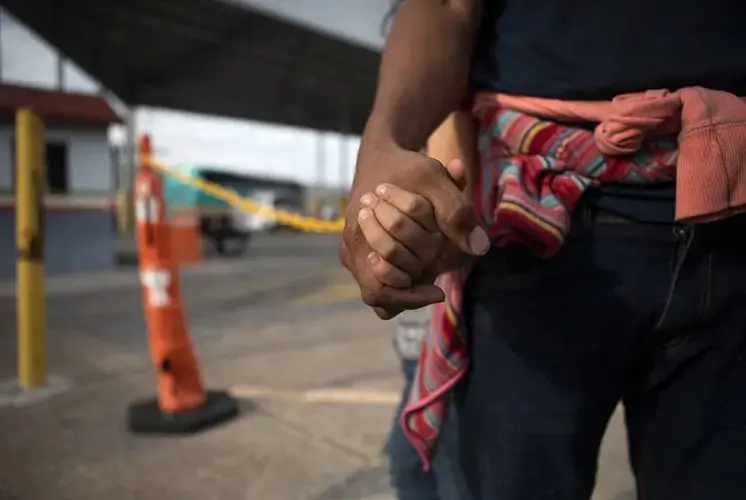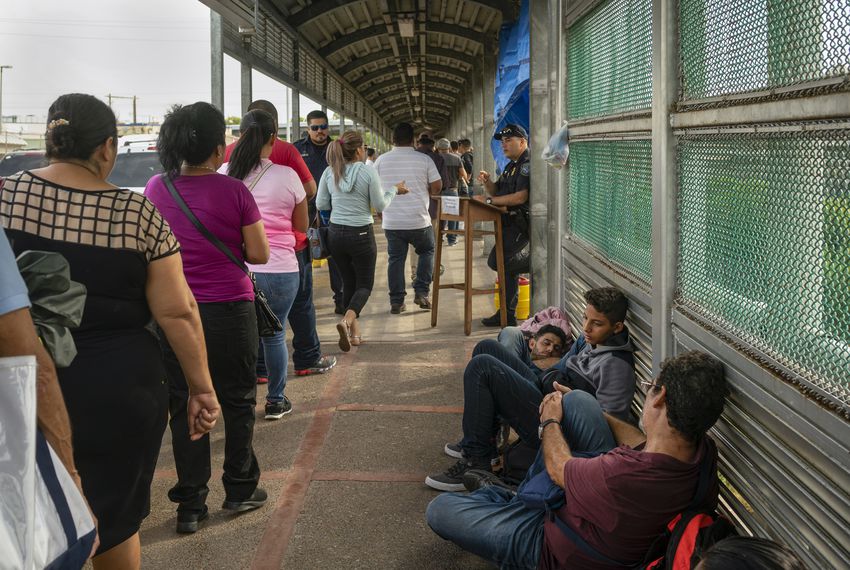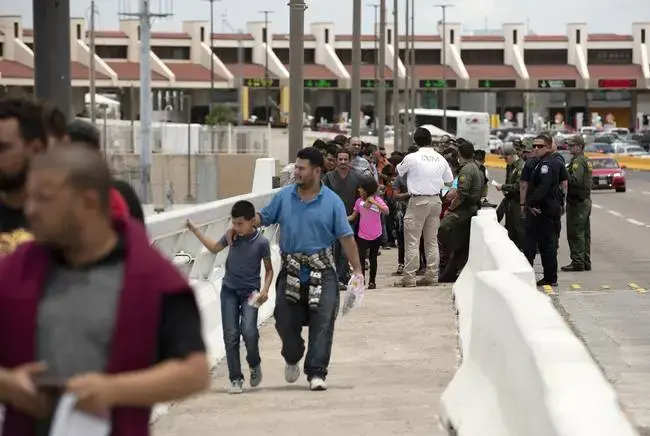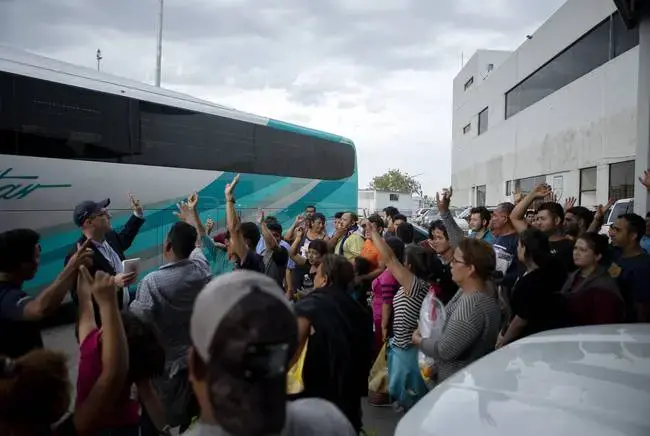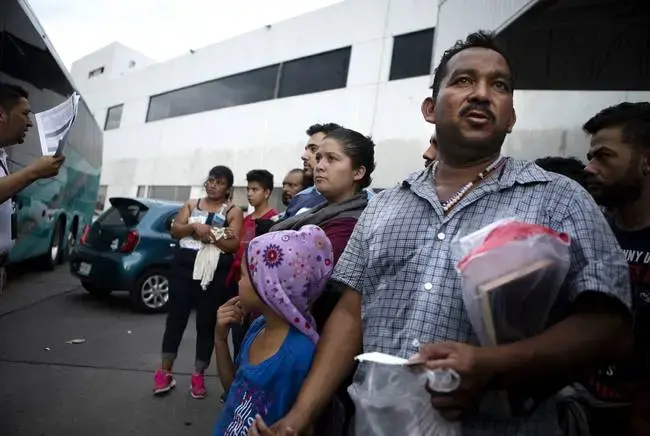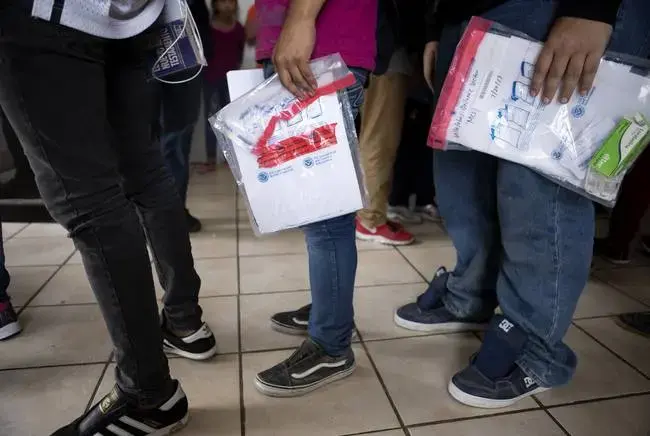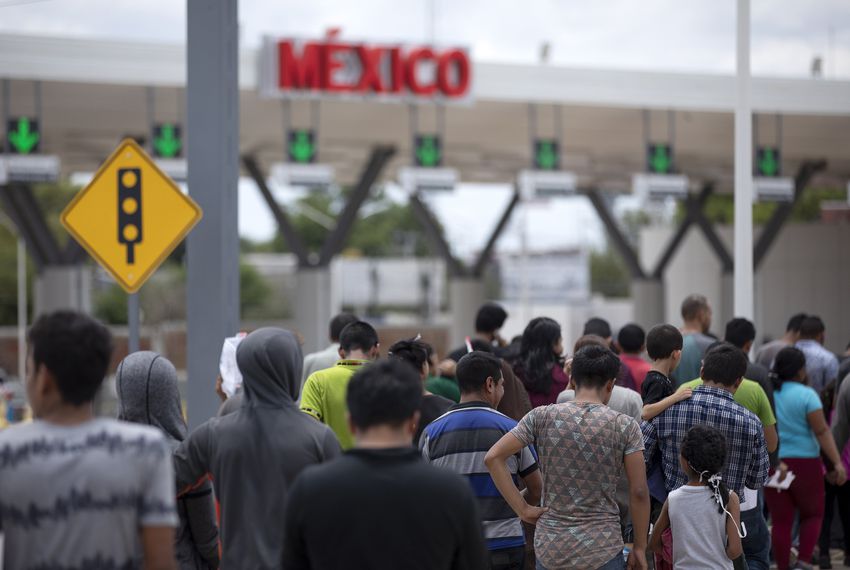
NUEVO LAREDO, Mexico — It was the first phone call to his family back in Honduras since crossing the Texas-Mexico border, and Olvin Alexander Buezo had bad news.
He wasn’t in the United States as expected. His 7-year-old son would not be attending elementary school this fall in Foley, Alabama. There would be no well-paying U.S. job to finance the $6,000 debt he incurred to pay their smuggler.
“I already told [my uncle] to sell everything,” Buezo said during the brief but somber phone call to his wife Tuesday. Their small “farm” — less than three acres — would have to go.
“There’s no other way,” he said. “The important thing is to get back home alive in Honduras.” By Thursday, Buezo was already in southern Mexico, on the way back home after abandoning his asylum claim.
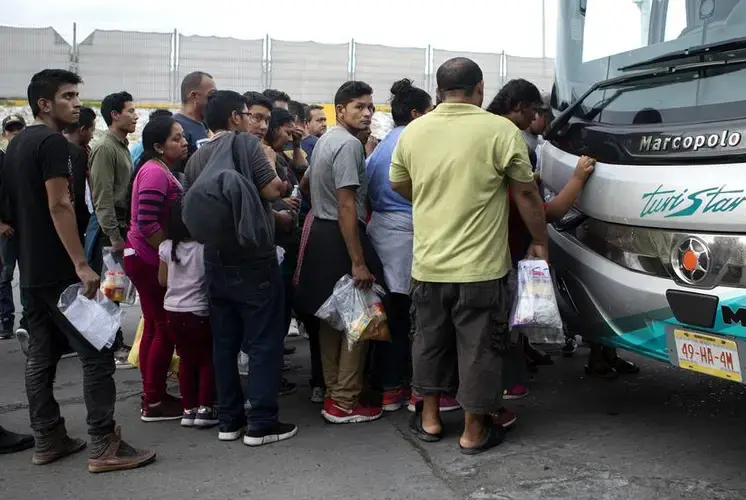
He wasn’t alone. On two recent afternoons this week at a Mexican migrant processing facility in Nuevo Laredo, The Texas Tribune asked dozens of Central Americans to raise their hands if they wanted to return to their countries of origin. Nearly all of them did.
They had just been marched across an international bridge from Laredo into Nuevo Laredo under the nascent “remain in Mexico” program. They said Mexican authorities gave them a choice: fend for themselves in the rough-and-tumble border town or board a chartered bus for a free ride to bustling Monterrey a few hours south. As night approached, dozens were opting for the safety of the bus over the mean streets of Nuevo Laredo, getting on board in the same clothes they had on when they crossed the border and carrying the asylum paperwork they got on the other side.
Many won’t be coming back. Although U.S. immigration officials had given each a “notice to appear” in coming weeks for asylum hearings at a yet-to-be-completed courthouse near the Rio Grande in Laredo, many said they’re giving up and returning home to avoid becoming sitting ducks for the local drug cartels or winding up deeper in debt for an ever-decreasing chance of gaining entry to the United States.
“We’re all traumatized,” said Cristian Urquiza, 31, who asked to be deported back to Honduras but instead was financing his own travel back after blowing $7,000 on a smuggler. “We’re afraid and we want to go home, even though we’re scared to return to our country.”
“If Honduras is dangerous,” Urquiza added, “Mexico is worse. It’s more dangerous.”
New U.S. policies wear down migrants
Shifts in migration patterns and flows can come suddenly, and they tend to defy easy explanations or confident predictions.
However, the new set of rules that pushed these Central Americans back into Mexico — despite vociferous protests from human rights activists and immigrant advocates — is fast becoming one of the Trump administration’s most successful strategies in keeping migrants from gaining entry into the United States at the southern border.
The official name for the “remain in Mexico” initiative is Migrant Protection Protocols, an ironic turn of phrase for migrants who feel anything but protected in Mexico. Launched in January in California, the initiative has since spread across the border all the way to deep South Texas. Activists have sued to stop it, but MPP has survived so far as legal challenges work their ways through the courts.
Although thousands of migrants have gone back to Mexico under MPP (more than 10,000 to Ciudad Juárez alone), requests to both U.S. and Mexican immigration authorities for the latest figures and comments about the program’s impact were not returned as of Friday morning.
One potential sign that many are giving up: A government official in Washington familiar with the MPP initiative said an estimated 40% of the migrants returned to Juárez from El Paso did not show up for their initial court hearings. The official did not have permission to comment on the record and spoke on condition of anonymity.
If MPP survives court challenges, it could significantly reduce the number of Central American migrants requesting asylum in the U.S., said Stephanie Leutert, a migration expert at the University of Texas at Austin. She said the ability for them to live and work in the U.S. while awaiting the outcome of their cases remains a big draw.
“If it’s expanded across the border, it is going to have a pretty dramatic effect, in my opinion, on the numbers of people who are coming,” Leutert said. “There is a big difference between waiting in Boston for your case and waiting in Mexicali or Monterrey.”
Some migrants are vowing to stick it out in Mexico no matter what. All the Cuban and Venezuelan asylum seekers interviewed by the Tribune in Nuevo Laredo, for example, said that despite the hardships, they were willing to wait.
Geovanys Isaac Garcia, 41, a migrant from Santiago, Cuba, is renting an apartment in Nuevo Laredo with two other Cubans in Colonia La Victoria, about 300 yards from Texas. Three months after arriving here, he was still waiting for his number to be called under the “metering” system that rations access to the ports of entry for asylum seekers.
He’s already seen other Cubans go to the bridge and come back with court dates set in September or October for their first hearings. He expects the same will happen to him when his number is called, and he’ll do just what they have done: go right back to their apartments in Nuevo Laredo, work in the black market economy here for $8-$10 a day and wait for a chance to make their case for U.S. asylum.
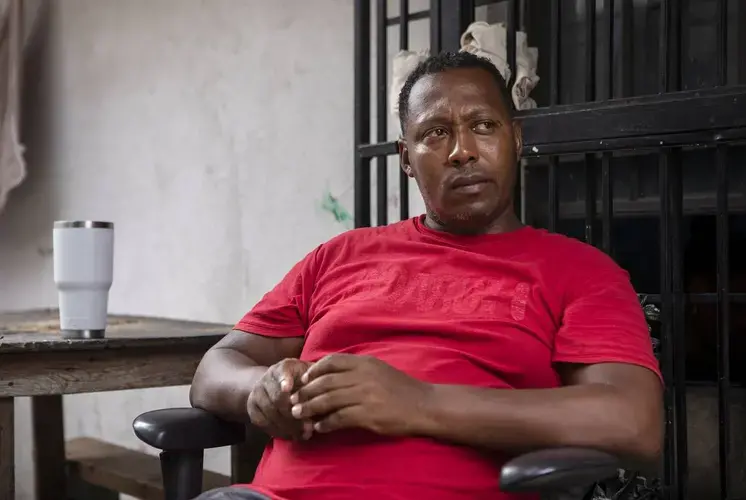
“It’s scary here, but Cuba is worse,” Garcia said. “Many of us have lost everything. If we returned to Cuba, we could run into trouble. ... We could end up in prison [for leaving the country].”
The thought of waiting for months on end terrifies Venezuelan migrant Amanda Riera, who, along with her three sons, was returned to Nuevo Laredo under the MPP program Monday after three days in detention. She was given an initial hearing date of Oct. 23.
While waiting for three months at the city-run shelter in Nuevo Laredo, Riera has seen trucks carrying armed men — “bad guys” — that others identified as cartel members. She’s also heard numerous gun battles raging at night. Riera has adopted a strategy of avoiding eye contact with strangers, changing up her routes, staying indoors at night and keeping her mouth shut.
“How secure are we here? I’m a mother of three, and I am practically living in hiding for fear of being kidnapped,” she said.
Still, she’d rather stay in Mexico and wait for a chance to claim asylum and join her husband, who crossed in December before the rules changed and is now living in Houston. Going home, to a country in the throes of an economic and political crisis that has provoked unprecedented outward migration, is unthinkable.
“Staying in Venezuela would mean delivering me to my death,” she said. “There my life and the life of my sons are in imminent danger ... because of political persecution.”
Escaping a kidnapping, then going home
Kidnapping is not an idle concern here. The Mexican state of Tamaulipas, which stretches from Nuevo Laredo to Brownsville, is the birthplace of the Gulf Cartel and its violent offspring, the Zetas, a faction of which rules Nuevo Laredo. The U.S. State Department’s “Do Not Travel” list warns U.S. citizens to stay away from Tamaulipas due to high rates of crime and kidnapping.
Kevin Guillermo Melendez, an 18-year-old migrant from El Salvador, said he was kidnapped in Nuevo Laredo on his way to the Rio Grande, where he intended to illegally cross into Texas. Even after his mother paid a ransom, Melendez sad, the kidnappers held him for several days until he managed to escape when they got drunk.
He finally hired a smuggler to get him across the border, only to find himself back in Nuevo Laredo this week under the MPP program. He hopped on one of the buses chartered by Mexican authorities that dumped him, penniless, in Monterrey.
His desperate mother, who lives in Maryland and hasn’t seen her son since he was 3, finally got to talk to him this week for the first time since he disappeared into the black hole of U.S. immigration detention, only to emerge back in the city where his kidnappers tormented him. Tears rolled down his face as he listened to her beg him to stay in Mexico and wait for his Sept. 20 hearing in Laredo.
“Are you crying?” she said.
“No,” he lied. He said he’d probably caught a cold.
Although he’s already dropped out of school to avoid the Salvadoran gangs that extort his mother under threat of kidnapping, on Friday he told the Tribune via a WhatsApp message that he’s leaving Monterrey — southbound.
“I’m going back to my country,” he said.
Most or all of the Central Americans who got on the bus to Monterrey with Melendez — drained of their money and hope — were making the same calculation. Franklin Lopez, 44, came to the U.S. border with his 8-year-old daughter and dreams of getting some new work tools he could bring back to Nueva Segovia, Nicaragua.
“We all came with the illusion that with a child you could get through, and unfortunately they reached the limit,” Lopez said. Now he’s headed home $8,000 lighter — $4,000 of it in the hands of a coyote who left him stranded in Guatemala and $4,000 spent to get across the U.S. border only to be sent back to Mexico a few days later.
For Urquiza, the Honduran migrant who called Mexico more dangerous than his native Honduras, the privations and abusive treatment he says he experienced during his week inside a U.S. migrant processing facility — where conditions have sparked outrage in Congress and beyond — snuffed out any remaining flicker of ambition he had to leave home.
“I don’t ever plan to take this path again,” Urquiza said. “I said this to an immigration officer — if this is the American dream, for me it’s an American nightmare.”
